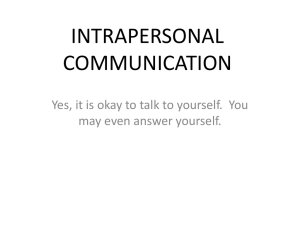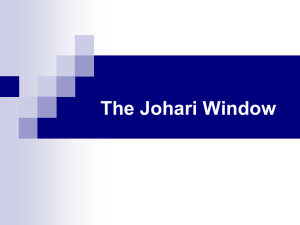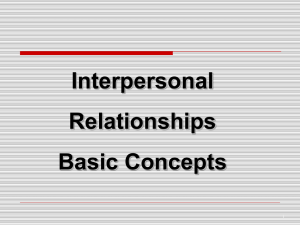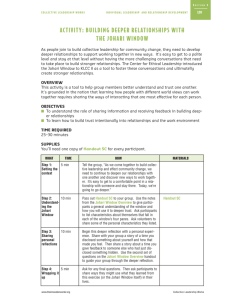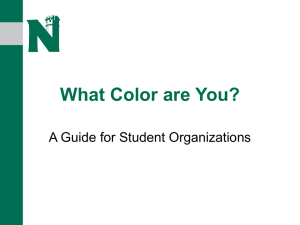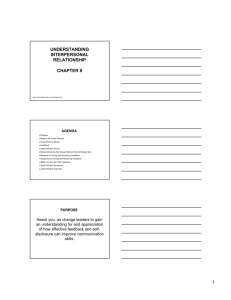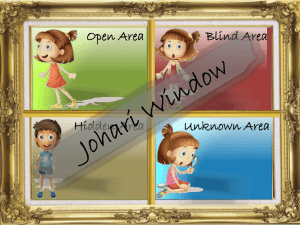Parent Summit 2014 True Colors
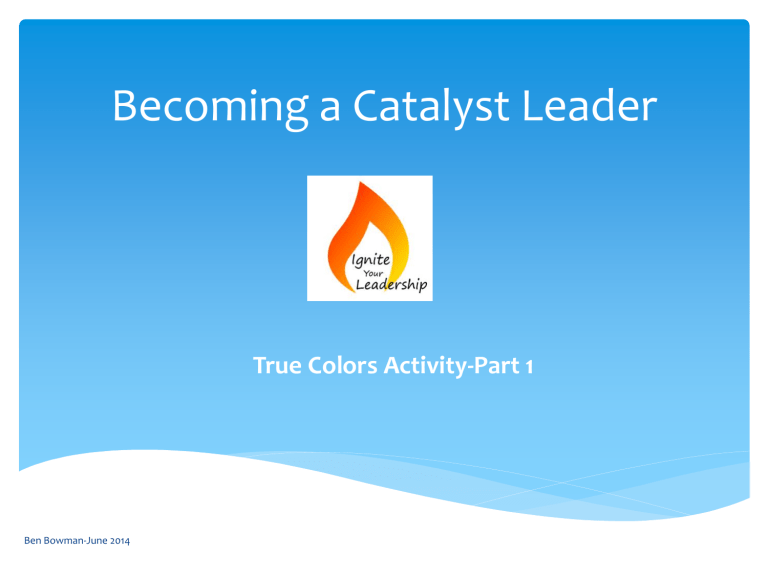
Becoming a Catalyst Leader
True Colors Activity-Part 1
Ben Bowman-June 2014
W
HAT IS TRUE COLORS
?
an inventory
an activity
a team-builder
(True Colors is a Trademark of True Colors International.)
Getting Started
Complete the 11 questions on page 3 of your handout
Give 4 points to the phrase “most like you”
3 to the next most like you
2 to the next and
1 point to the phrase least like you.
Getting Started
Add up your responses on page 5 of your handout
Identify a primary & secondary color---your 2 highest numbers
These two colors are your preferred styles
C D
1
2
Question
Number
3
A
(response)
4
B
2 1 3
P OINTS T O REMEMBER
All colors are a part of you---not all are preferred styles.
Valuable for improving your effectiveness in working with others
Everyone is unique and everyone has potential for growth and change
T HE F OUR T RUE C OLORS
Blue
Relationship oriented
Gold
Structure oriented
Green
Cognitive oriented
Red
Intuition oriented
Please pick up your color bands as you leave. If you had a tie score on some of the colors, please pick up one band for each color.
Becoming a Catalyst Leader
Part 2: Leadership Growth Through Understanding Yourself and Others
What is a Catalyst Leader?
Someone who sparks action in others.
What Defines a Catalyst Leader?
Their approach to people and leadership.
What they provide for the people they lead.
What they ask of and encourage in the people they lead.
What Defines a Catalyst Leader?
How they conduct themselves.
Their impact on people and results.
A willingness to walk (or roll) with and learn from everyone.
An Example of Catalyst Leadership:
Eric Schmidt, Larry Page & Sergey Brin :
Bill Campbell
Ben Bowman
Successful Leaders:
Understand themselves
Understand their reactions
Know how to maximize what they do well
Have a positive attitude
Know how to adapt their behavior
How does prior knowledge and life experience affect our interactions?
Consider the Johari Window
1
Open/
Free area
2
Blind Area
3
Hidden
Area
4
Unknown
Area
Joseph Luft &
Harry Ingham, 1955
Johari region
1
Known by the person ('the self') and known by the group
('others').
Open/Free Area Blind Area
Hidden Area Unknown Area
Johari region 2
What is known about a person by others in the group, but is unknown by the person him/herself.
Region 1
Open/Free Area
Region 2
Blind Area
Region 3
Hidden Area
Region 4
Unknown Area
Johari region 3
What is known to us but kept hidden from, and therefore unknown , to others.
Region 1
Open/Free Area
Region 2
Blind Area
Region 3
Hidden Area
Region 4
Unknown Area
Johari region 4
Unknown to the person him/herself and unknown to others in the group.
Region 1
Open/Free Area
Region 2
Blind Area
Region 3
Hidden Area
Region 4
Unknown Area
Johari window model
- example for someone we just met
-The open free region is small because others know little about the new person.
-Similarly the blind area is small because others know little about the new person.
-The hidden or avoided issues and feelings are a relatively large area.
-The unknown area is the largest, which might be because the person is young, or lacking in self-knowledge or belief.
Johari window- Someone we know
The open free area is large
Unknown area is smaller
WHAT IS YOUR COLOR?
BLUE GOLD GREEN Red
Esteemed by:
Appreciated
For:
Validated By:
Helping
People
Unique
Contributions
Personal
Acceptance
A Facilitator At work they are:
Their specialty is:
Relationships
Overall mood Committed
Being of
Service
Accuracy and
Thoroughness
Appreciation of Service
Procedural
Insights
Their Ideas
Affirming
Their Wisdom
Pragmatic
Results
Concerned
Strategy
Recognition
Creativity
Visible Results
Flexible
Energy
Enthusiastic
Key character trait:
Authenticity Responsibility
Cool, Calm,
Collected
Ingenuity Skillfulness
Blue
Expects others to express views
Assumes “collaborative spirit”
Works to develop others potential
Democratic, unstructured approach
Encourages change VIA human potential
Expects people to develop their potential
Gold
Expects punctuality, order, loyalty
Assumes “right” way to do things
Seldom questions tradition
Rules oriented
Detailed/thorough approach, threatened by change
Prolonged time to initiate any change
Expects people to play their roles
Green
Expects intelligence and competence
Assumes task relevancy
Seeks ways to improve systems
Visionary
Analytical
Encourages change for improvement
Constantly “in process” of change
Expects people to follow through
Red
Expects quick action
Assumes flexibility
Works in the here and now
Performance oriented
Flexible approach
Welcomes change
Institutes change quickly
Expects people to “make it fun”
Please Consider
Red Red
What…
… are the needs of your primary color?
… frustrates you about other colors?
… frustrates you about your color?
… traits of your color serve as an asset in your role as a parent?
How could knowing about your color (behavioral style) and colors (behavioral styles) of family members or those with whom you interact be beneficial?
True Colors Activity
Consider assignment 1 on page 15 of the handout.
Review the Leadership Action Plan on Page 18 and complete the first two sections
Find someone with a different color wristband for section 3 and complete the activity
True Colors Exercise
Interview Questions:
1. Tell me how you dealt with a major frustration in one of your previous projects or areas of responsibility.
2. Please explain what kind of environment has been important for you to best demonstrate your potential.
3. Describe how you were involved with a significant achievement in a previous life experience.
How Do We Recognize a Catalyst Leader?
Take a look in the mirror Take a look at your children
